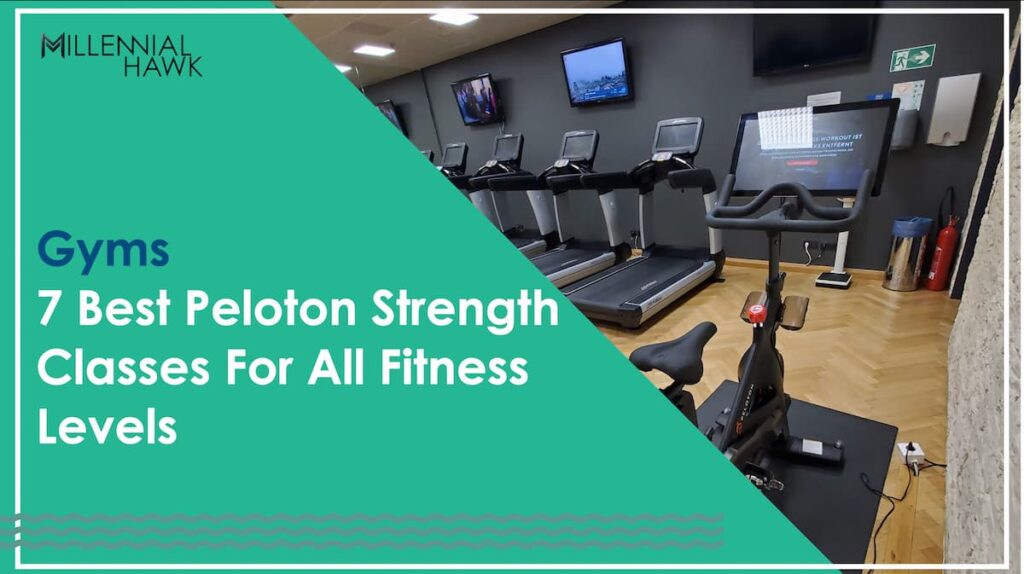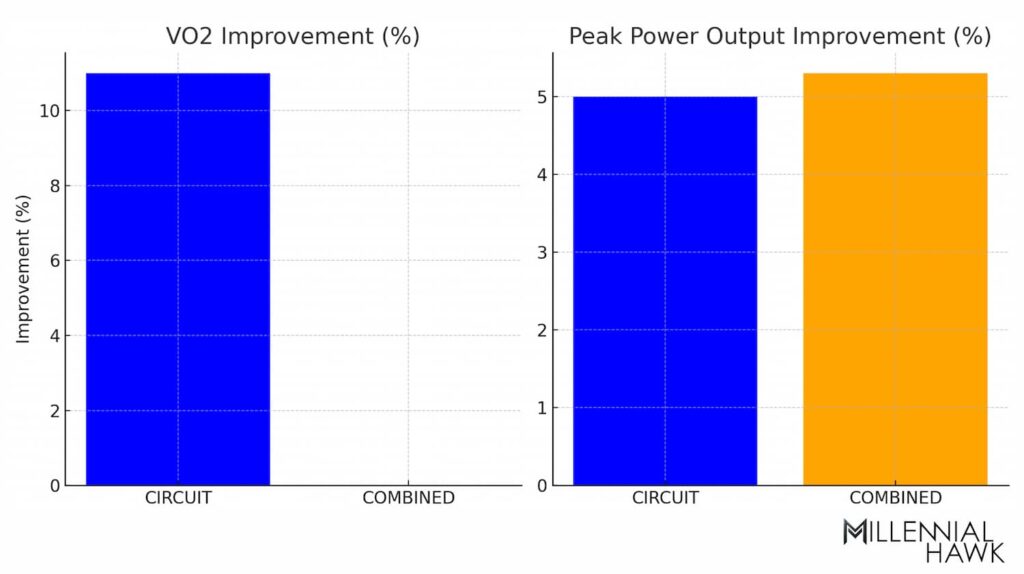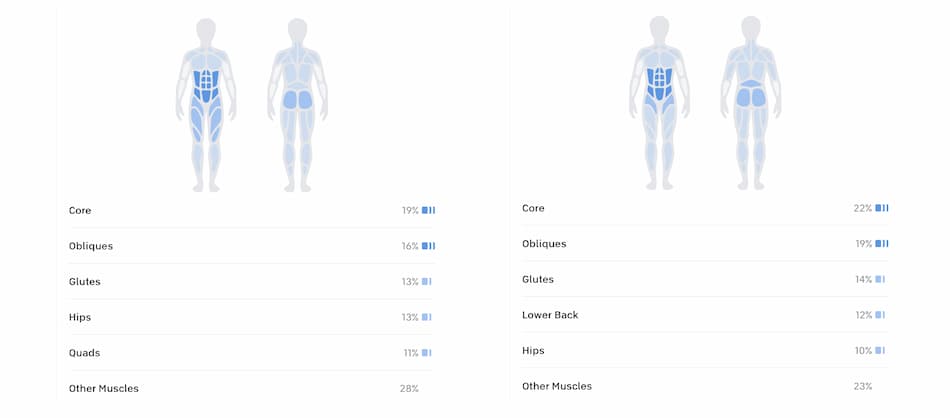
Peloton strength classes, also known as Peloton toning classes, encompass a wide variety of video workouts spanning 14 categories. These workouts range from total body strength routines to sessions that focus on specific muscle groups, suitable for beginners, intermediates, and advanced fitness levels. The best part is that you don’t necessarily need Peloton equipment; basic accessories like a workout mat, dumbbells, resistance bands, or even just your body weight is enough for Peloton strength classes.
The best Peloton strength classes include Peloton Roll Call sessions and Full Body Workouts. These classes excel at building overall muscle strength and providing a solid foundation while getting your heart rate up and torching calories. They follow a circuit training style where you do each exercise for 30-40 seconds with 10 seconds of rest in between.
For those aiming for weight loss, the 60-minute Total Strength with Andy Speer is a winner. In this class, you perform 30 different moves with an AMRAP (as many reps as possible) approach, with 30 seconds of rest between sets. Plus, you get to work with all three types of weights. It’s a fantastic choice for shedding those pounds while getting stronger.
This Peloton strength classes review covers the 7 best workouts, which are listed below. It also explains how to create your Peloton strength workout plan, who the best Peloton strength instructors are, the best weights for Peloton strength, and how Peloton calculates calories for strength training.
- Peloton Roll Call Classes
- Peloton Bodyweight Strength Classes
- Peloton Full Body Strength Classes
- Peloton Glutes & Legs Strength Classes
- Peloton Adaptive Classes
- Peloton Barre Classes
- Peloton Pilates Classes
1. Peloton Roll Call Classes
Peloton Roll Call strength classes are a series of structured workouts offered from Monday to Friday at 7:30 am ET, followed by an Encore class at 5:00 pm ET on the same day or in the following week. These classes serve as the best Peloton strength workouts for overall fitness, as they provide members with a consistent schedule for their strength training, eliminating the guesswork in selecting which classes to take.
What I like about the Peloton Roll Call workouts is that they give me a solid daily routine, making it a breeze to stick to them. Each day has a different focus, so you can work on specific muscles and switch things up for a well-rounded fitness week.
The weekly Peloton strength roll call schedule includes 4-5 full-body, glutes and legs, core, and upper-body workouts, ensuring a well-rounded fitness routine. This table shows the Peloton weekly roll call.
| Day | Time | Class Type | Instructor |
|---|---|---|---|
| Monday | 7:30 a.m. ET | Live 20-min Full Body | Rebecca Kennedy |
| Monday | 5:00 p.m. ET | Encore 20-min Glutes & Legs | Adrian Williams |
| Tuesday | 7:30 a.m. ET | Live 20-min Glutes & Legs | Adrian Williams |
| Tuesday | 5:00 p.m. ET | Encore 15-min Core | Callie Gullickson |
| Wednesday | 5:00 p.m. ET | Encore 20-min Upper Body | Jermaine Johnson |
| Thursday | 7:30 a.m. ET | Live 20-min Upper Body | Ben Alldis |
| Thursday | 5:00 p.m. ET | Encore 20-min Full Body | Rad Lopez |
| Friday | 7:30 a.m. ET | Live 30-min Bodyweight | Rad Lopez |
| Sunday | 5:00 p.m. ET | Encore 20-min Full Body | Rebecca Kennedy |
Between 14 to 16 new Peloton Roll Call workouts are introduced each month, with exclusions during holidays and summer. These sessions are led by 12 Peloton Instructors, including Ben Alldis, Rebecca Kennedy, and Jermaine Johnson. To find Roll Call classes on the Peloton app, simply scroll to the top of the screen, find the search icon, and enter “Roll Call,” which will display all Peloton Roll Call classes.
2. Peloton Bodyweight Strength Classes
Peloton Bodyweight strength workouts, also known as Peloton calisthenics, are classes that are based on classic principles of physical education, typically performed on the floor, without the need for dumbbells, bands, or other accessories, although they can be done with the Peloton Guide. These workouts usually last between 10 to 30 minutes and do not require the use of a Peloton bike, tread, or rower. Longer sessions exceeding 40 minutes are rare, and they are exclusively available in the German language. Peloton Bodyweight strength classes can be accessed on-demand or in a live format but are not offered in person at the Peloton NYC studio.
When asking are Peloton bodyweight strength workouts effective, we can reference a 2021 study by Linda R. Archila published in the International Journal of Exercise Science. The study found that a brief 11-minute bodyweight training session, including exercises like burpees and squat jumps, significantly improved peak oxygen uptake. Specifically, after the six-week program, the group that performed the bodyweight training had a VO2peak of 34.2 ml/kg/min, while the control group had a VO2peak of 30.3 ml/kg/min.
Peloton Bodyweight strength classes include a combination of compound movements. This class is considered the best Peloton strength class for seniors because it offers easy exercises suitable for individuals without prior fitness experience, helping them build strength while improving mobility and range of motion. The most challenging Peloton Bodyweight Strength class is the 45-minute Bodyweight Strength with Assal Arian. Other Peloton instructors teaching Bodyweight Strength include Adrian Williams, Andy Speer, and Ben Alldis.
3. Peloton Full Body Strength Classes
Peloton’s Full Body Strength classes are the most popular strength training program on Peloton, with over a thousand workouts available on demand, live, and in person at the Peloton London studio. These classes range from 10 to 60 minutes in duration and require various accessories such as free weights, resistance bands, or kettlebells. Weights needed for Peloton Full Body Strength classes include light, medium, and heavy options.
Peloton Full Body Strength is the ideal Peloton strength class for improving endurance because it incorporates circuit-style training with an average of 30 different exercises performed based on reps, time, AMRAP, or EMOM, depending on the class duration, all executed back to back. A 2015 study by Terrence R. Myers from the University of Lethbridge compared circuit-style training with a traditional regimen of strength training followed by cardio.
The study found that 20-30 minutes of circuit-style training significantly improved anaerobic capacity by 11%, and relative peak and average power output by 5%, as shown in this diagram.

In contrast, no such improvements were observed in the group that combined traditional strength and aerobic exercises. Therefore, when designing your Peloton full-body workout plan, make sure to include 2-3 full body strength workouts.
For beginners, the best Peloton full-body workout is the 20-minute duration, especially suitable for those who are overweight. It allows them to stimulate training adaptations without the risk of overtraining or fatigue. The best instructors for Peloton Full Body strength workouts include Selena Samuela, Andy Speer, and Rad Lopez.
4. Peloton Glutes & Legs Strength Classes
Peloton Glutes & Legs Strength, also known as the Peloton Glutes workout, is the recommended class to strengthen your glutes, the largest muscles in your body. Peloton doesn’t have separate 4-week programs for glutes, so Glutes & Legs Strength is one of the few options you have to grow your glutes. A Peloton glute workout is essential, especially for people who complain about Peloton hurting their butt, experiencing numbness and tingling in the buttock after rides, or just wanting to develop their glutes with Peloton.
Peloton’s Glutes & Legs Strength class is the best class for lower body strength on Peloton because the gluteus muscles play a significant role in stabilizing the pelvis and generating power during pedaling. Strengthening these muscles not only enhances cycling efficiency but also helps prevent issues like gluteus medius syndrome, improving overall cycling performance and comfort.
I could spend a whole day talking about the importance of glute training. There are dozens of reasons why I recommend trying the Peloton glute workout, such as improving posture, increasing power output on the bike, enhancing your FTP score, reducing back and knee pain, and helping you achieve a more athletic appearance.
The best Peloton classes for glutes include not only Peloton strength sessions but also bike rides like Peloton Climb ride and HIIT and Hills. These rides require you to stand out of the saddle, engaging your glutes effectively. If you’re looking for Peloton workouts for a big butt, consider stacking multiple workouts together, such as Glutes & Legs Strength, Peloton Barre Glutes, and Climb Rides, back to back.
5. Peloton Adaptive Classes
Peloton’s Adaptive Classes, part of the Adaptive Training Collection led by instructor Logan Aldridge, are the best Peloton strength classes for athletes with various physical abilities, offering both seated and standing formats. These inclusive workouts range from 10 to 20 minutes and include full-body strength training and bodyweight exercises, making fitness accessible to a broad audience. The collection is continuously expanding to support adaptive athletes.
The recent addition to Peloton’s offerings is the Standing Adaptive Strength program, a 7-day series with 11 classes focused on strengthening key muscle groups for standing adaptive athletes, featuring Bronze, Silver, and Gold completion badges. Peloton’s partnership with the Christopher & Dana Reeve Foundation has led to the creation of the “Seated Adaptive Strength” program, an eight-class series designed for wheelchair users with spinal cord injuries, focusing on workouts that require some hand and arm function.
6. Peloton Barre Classes
Peloton Barre is a form of physical exercise that includes a diverse range of core-strengthening classes that vary in duration from 5 to 45 minutes, with some of the most challenging sessions lasting just 10 minutes. Led by instructors like Ally Love and Hannah Corbin, Peloton Barre stands out as one of the best Peloton strength workouts for women due to its low-impact, high-intensity, pulsatile isometric movements.
What sets Peloton barre classes apart is that you don’t need any specialized equipment like a bike, treadmill, or rower. While in-person Peloton Barre classes can be hard to come by, it’s worth noting that despite its relatively recent addition to the Peloton library, the Peloton Barre workout schedule has gained more popularity than Pilates, resistance bands, and boxing bootcamp combined. On average, Peloton introduces 11 new Barre workouts every month.
7. Peloton Pilates Classes
Peloton Pilates is a core-centered bodyweight strength training program that prioritizes slow and controlled movements. While Peloton’s Pilates program differs from the traditional classical mat Pilates routine, it shares its foundation in these movements. Peloton instructor Anna Greenberg notes, “Pilates is a very precise practice that aims to organize the body and optimize its movements.”
Pilates is the best Peloton strength class for lower back pain due to its low-impact nature, focus on core stability and attention to spinal alignment. These 10 to 45 minute classes don’t require any specialized equipment, making them an ideal workout choice for back pain and hip pain. You can access Pilates classes on-demand and in live sessions, although in-person Peloton Pilates classes are relatively rare. The instructors break down the movements in a way that quickly makes you feel like a professional.
One of the standout instructors for Peloton Pilates strength classes is Emma Lovewell, who focuses extensively on core stability and strength. Her 20-minute class also incorporates exercises for the arms and shoulders, gradually increasing intensity as the session progresses. Emma provides plenty of modifications, making her classes beginner-friendly.

Above you can see the muscle activity from the typical peloton pilates class (beginner level). This class is where you lay on the floor on your back. Warm-up is slow and helps to move your joint around. All PIlates Strength beginner-level classes have a good balance between intensity and rest. This is a great option for people who need more time to get started before they jump into weight training.
What are the Different Types of Peloton Strength Classes?
The following list shows different types of Peloton classes from the strength category.
- Warm Up
- Bodyweight
- Full Body
- Core
- Upper Body
- Lower Body
- Arms & Light Weights
- Peloton Strength for Runners
- Resistance Bands
- Adaptive
- Barre
- Pilates
- Boxing Bootcamp
What is the Peloton Strength Training Program?
The Peloton Strength Training Program is a structured, multi-class series that spans several weeks, offering a variety of strength training programs. Among all Peloton programs, those that focus on strength training include eight options, such as:
- Beginner Strength with Matty and Olivia
- Beginner Pilates
- Total Strength with Andy
- Total Strength 2 with Andy
- Total Strength (German) with Erik
- Crush Your Core with Emma
- Crush Your Core 2 with Emma
- Adaptive Strength with Logan
When asking about the best Peloton beginner strength program, Peloton instructor Ben Alldis, in his Facebook livestream, recommended starting with the Total Strength 2 program led by Andy Speer, designed to help individuals level up over a four-week period.
How often should you do Peloton Strength Classes?
The frequency of Peloton Strength Classes varies based on your fitness level. Beginners can aim for 3-4 sessions per week, while experienced individuals can consider 5 to 7 sessions weekly, adjusting intensity and duration as needed and potentially incorporating them into their bike routine.
What is the Best way to Build Strength with a Peloton?
The best way to build strength with Peloton is to focus on resistance training classes that include sets performed until volitional failure with moderate to high loads, also known as AMRAP (as many reps as possible). A 2021 study by Pedro Lopez and Régis Radaelli from Universidade Federal do Rio Grande do Sul suggests that muscle hypertrophy improvements are not significantly influenced by the resistance load, but rather by reaching the point where you can’t do another repetition or lift any more weight because your muscles are exhausted.
When designing your Peloton strength training plan, ensure you include the 60-minute Total Strength with Andy Speer, as these workouts focus on reps and time under tension.
How to Make a Peloton Strength Workout Plan?
To create a Peloton strength workout plan, follow these seven steps.
- Follow the Peloton Total Strength with Andy six-week program or choose workouts and classes to suit your preference.
- Keep an eye out for the new Peloton strength programs, as new ones are released a few times each year.
- Explore the Peloton split strength program to enhance your fitness regimen.
- Combine cycling and strength to create the Peloton bike and strength workout plan.
- Plan and determine the number of workouts in your weekly Peloton strength training schedule.
- Look up Peloton strength training before and after for motivational success stories and visual transformations.
- Get to know the Peloton strength instructors and find the ones that you like.
What is the Peloton strength training for Runners?
Peloton’s strength training for runners is a comprehensive series of classes designed to improve running performance, balance, and recovery by strengthening and increasing flexibility in muscles typically underused during running. Professional athletes like Scout Bassett and Colleen Quigley use Peloton Strength for runners training to enhance their aerobic threshold, VO2 max, and core muscles, targeting both deep and superficial abdominal muscles.
What is the Peloton strength training for Beginners?
Peloton’s strength training program for beginners is a 6-week progressive program known as “Peloton Beginner Strength.” This program is designed to introduce you to strength and weight training. Unlike other strength or weight loss programs, this six-week program guides you through proper form, strength techniques, and movements, teaching correct techniques for exercises such as squats, deadlifts, push-ups, and lunges. Led by instructors Matty Maggiacomo and Olivia Amato, this program includes a total of 42 classes. This table summarizes the schedule for each week of the Peloton strength training for beginners program:
| Week | Focus | Peloton Classes |
|---|---|---|
| 1 | Stabilization and core strength | 10 min Full Body Strength Warm Up with Olivia Amato 30 min Bodyweight Strength with Matty & Olivia 10 min Full Body Stretch with Matty Maggiacomo |
| 2 | Core stabilization and balance | 10 min Full Body Strength Warm Up with Olivia Amato 30 min Bodyweight Strength with Matty Maggiacomo 10 min Full Body Stretch with Matty Maggiacomo |
| 3 | Strength endurance | 10 min Full Body Strength Warm Up with Olivia Amato 30 min Bodyweight Strength with Olivia Amato 10 min Full Body Stretch with Matty Maggiacomo |
| 4 | Introduction to weights | 10 min Full Body Strength Warm Up with Olivia Amato 30 min Full Body Strength with Matty & Olivia 10 min Full Body Stretch with Matty Maggiacomo |
| 5 | Intensive full-body workouts | 10 min Full Body Strength Warm Up with Olivia Amato 30 min Upper Body Strength with Matty Maggiacomo 10 min Full Body Stretch with Matty Maggiacomo 30 min Glutes & Legs Strength with Olivia Amato |
| 6 | Dynamic movements | 10 min Full Body Strength Warm Up with Olivia Amato 30 min Upper Body Strength with Matty Maggiacomo 10 min Full Body Stretch with Matty Maggiacomo 30 min Glutes & Legs Strength with Olivia Amato 30 min Full Body Strength with Matty & Olivia |
What are the Best Peloton Strength classes for Weight Loss?
For effective weight loss through Peloton strength classes, consider the 60-minute Total Strength class led by Andy Speer. During this session, you’ll engage in approximately 30 different moves, following an AMRAP (As Many Reps As Possible) protocol. According to a 2021 study conducted by Ronam Toledo from the Federal University of Juiz de Fora, this combination is effective for endurance and weight loss. This workout provides a balanced physiological response in terms of heart rate, blood lactate levels, and training load, making it a well-rounded choice for both men and women looking for a comprehensive and efficient fitness routine.
Which weights are needed for Peloton Strength Workouts?
For Peloton strength workouts, it’s recommended to have two sets of dumbbells: 5-10 lbs each for females and 10-20 lbs each for males. Beginners can start with lighter weights in the 5-10 lbs range and gradually increase as they advance. The key to building muscle in these classes isn’t solely about heavy weights; it’s also about the time under tension. Therefore, Peloton weights for strength training, even lighter ones, can be effective due to the variety of exercises targeting the same muscle groups.
What are the Best Peloton Strength Instructors?
The best Peloton strength instructors, including Adrian Williams, Andy Speer, and Assal Arian, stand out due to their unique training styles, motivational abilities, and emphasis on technique and form. However, Emma Lovewell holds the title of the most popular Peloton strength instructor, thanks to her charismatic teaching style, well-structured classes that strike a balance between intensity and fun, and her knack for connecting with a diverse audience.
How does Peloton calculate calories for strength training?
Peloton calculates calories burned during strength training primarily through data from the heart rate monitor. This device tracks your heart rate throughout the workout and uses it, along with your personal profile information like weight and age, to estimate the number of calories burned.
Are Peloton Strength Workouts Effective?
Yes, Peloton strength workouts are effective in building muscle and losing weight because they combine a variety of targeted exercises led by experienced instructors, enhancing both strength and overall fitness. However, Peloton strength classes are not ideal for those seeking personalized weightlifting programs or specific metrics tracking during workouts.
How effective are Peloton strength classes for beginners?
Peloton strength classes are highly effective for beginners as they offer a variety of workouts that cover all muscle groups, making it a comprehensive starting point for resistance training. These classes allow you to choose appropriate weights, and instructors provide modifications, ensuring you can tailor the intensity to your fitness level and gradually progress as you build strength.
Does Peloton display metrics during strength classes?
Yes, Peloton displays various metrics during strength classes, including your Strive Score, heart rate, calories burned, and even your form tracker when using the Peloton Guide. However, you won’t see metrics for the number of reps or power output during these classes.
Is Peloton Digital Enough for Strength Training?
Yes, Peloton’s digital platform is sufficient for strength training, even without the bike, tread, or rower, offering a wide array of on-demand and live strength-focused classes accessible from any location. However, it’s not enough if you require equipment-based workouts, personalized weight training guidance, or specific fitness metrics tracking.
Does Peloton have functional strength training?
No, Peloton does not specialize in functional strength training that specifically targets everyday movement.
